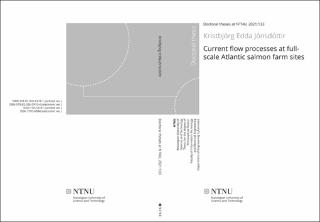| dc.contributor.author | Jónsdóttir, Kristbjörg Edda | |
| dc.date.accessioned | 2021-04-07T11:57:16Z | |
| dc.date.available | 2021-04-07T11:57:16Z | |
| dc.date.issued | 2021 | |
| dc.identifier.isbn | 978-82-326-5910-4 | |
| dc.identifier.issn | 2703-8084 | |
| dc.identifier.uri | https://hdl.handle.net/11250/2736615 | |
| dc.description.abstract | The aquaculture industry has grown exponentially the last 30 years. In Norway the Atlantic salmon is the dominant species and the rapid growth of the industry has led to both challenges and controversy. The issues faced by the industry are multifaceted and two of the most pressing issues that hinder expansion of the industry are lack of space and salmon lice. Several different solutions are employed to reduce the salmon lice infestation. Some argue that prevention based methods such as the lice shielding skirt may be the solution, while others suggest that both issues can be solved by moving to more exposed farm sites.
Independently of farm design all production units at sea must take into consideration the impact of the ocean currents. This holds particularly true for exposed sites where the ocean current is expected to have periods of stronger and more persistent water flow. For cages based on the traditional "Grøntvedt" design that utilises nets to keep the fish, the current flow plays a vital role in how dissolved oxygen, nutrients, waste and food pellets and transported through and downstream of the cage. As the current passes through the net the speed is reduced and a portion of the current is diverged around the cage. At exposed sites, this reduction may be beneficial with regards to the wellbeing of the fish. However, at more sheltered sites weak currents may lead to poor water exchange resulting in low dissolved oxygen levels which are necessary for the fish to thrive. The use of lice shielding skirts to fend off the salmon lice can further reduce the current flow and result in an unhealthy environment for the fish.
The main objective of this thesis was to gain new insight into the current flow at full-scale sites and inside the cages. Specifically the interest was how current conditions at exposed sites could be evaluated using fish welfare criteria, and how lice shielding skirts influenced the current conditions. As the current flow at individual sites depend on many factors such as topography, hydrography, farm layout, cage design and more, this was studied through collecting existing long-term data sets from five sites along the Norwegian coastline, as well as designing and executing three full-scale experiments.
A classification scheme based on the swimming capacities of Atlantic salmon was developed and applied on the current flow data from the five sites to evaluate if fish welfare was maintained for Atlantic salmon and lumpfish. Only one of the five sites was found acceptable for lumpfish, while four were found acceptable for small salmon post-smolt. The full-scale experiments investigated different aspects of the interaction between lice shielding skirts and current flow. The first studied the impact of a non-permeable tarpaulin skirt on the current flow field inside the cage, while the second established the characteristic current flow field around a conical sea cage equipped with a permeable skirt. The results indicated that the influence of the conical cage on the downstream current disappeared as the diameter of the cage decreased with depth. The reduction in current speed was established for both of these cages and were higher than reduction through non-shielded cages. Finally, the impact of shielding skirt on dissolved oxygen levels inside cages were determined at two hydrographically different sites, revealing a complex interaction between dissolved oxygen level, skirt, ocean currents and local stratification. | en_US |
| dc.language.iso | eng | en_US |
| dc.publisher | NTNU | en_US |
| dc.relation.ispartofseries | Doctoral theses at NTNU;2021:133 | |
| dc.relation.haspart | Paper A:
Jónsdóttir, Kristbjörg Edda; Hvas, Malthe; Alfredsen, Jo Arve; Føre, Martin; Alver, Morten; Bjelland, Hans Vanhauwaert; Oppedal, Frode. Fish welfare based classification method of ocean current speeds at aquaculture sites. Aquaculture Environment Interactions 2019 ;Volum 11. s. 249-261
https://doi.org/10.3354/aei00310
Open Access under Creative Commons by
Attribution Licence (CC-BY) | en_US |
| dc.relation.haspart | Paper B:
Jónsdóttir, Kristbjörg Edda; Volent, Zsolt; Alfredsen, Jo Arve. Dynamics of dissolved oxygen inside salmon sea-cages with lice shielding skirts at two hydrographically different sites. Aquaculture Environment Interactions 2020 ;Volum 12. s. 559-570
https://doi.org/10.3354/aei00384
Open Access under Creative Commons by
Attribution Licence (CC-BY) | en_US |
| dc.relation.haspart | Paper C:
Jónsdóttir, Kristbjörg Edda; Volent, Zsolt; Alfredsen, Jo Arve. Current flow and dissolved oxygen in a full-scale stocked fish-cage with and without lice shielding skirts. Applied Ocean Research 2021 ;Volum 18.
https://doi.org/10.1016/j.apor.2020.102509
This is an open access article under the CC BY license (http://creativecommons.org/licenses/by/4.0/) | en_US |
| dc.relation.haspart | Paper D:
Jonsdottir, Kristbjørg Edda; Pascal, Klebert; Volent, Zsolt; Alfredsen, Jo Arve. Characteristic current flow through a stocked conical sea-cage with permeable lice shielding skirt.
Ocean Engineering 2021 ;Volum 223. s. 108639
https://doi.org/10.1016/j.oceaneng.2021.108639
This is an open access article under the CC BY license (http://creativecommons.org/licenses/by/4.0/). | en_US |
| dc.title | Current flow processes at fullscale Atlantic salmon farm sites | en_US |
| dc.type | Doctoral thesis | en_US |
| dc.subject.nsi | VDP::Technology: 500::Information and communication technology: 550::Technical cybernetics: 553 | en_US |
